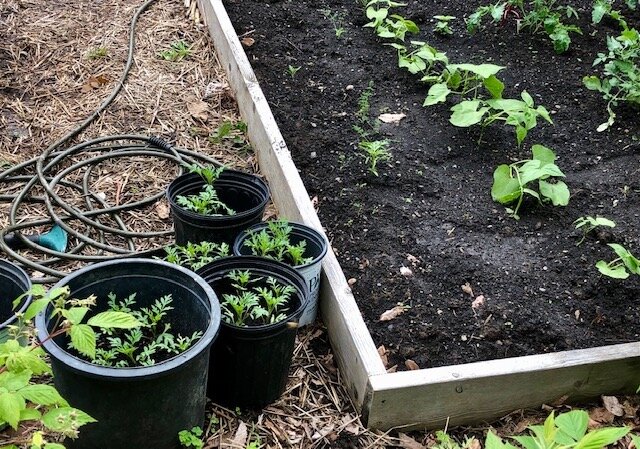Plan ahead for holes: How to put leftover annuals to good use
In June, you can sit back on your laurels and admire your garden to your hearts content. Perennials are starting to bloom and any annuals you planted are just beginning to do their thing. You may think you’re golden, but wait - what about those future holes that mar your garden in late summer?
Most of us have them. Here are a couple of my problem spots. Right now that combination of Alium schubertii and Ornithogalum ponticum ‘Sochi’ are rocking the space between the lavender Verbena bonariensis, but what’s it going to look like in July and August? Even if I leave the seed heads of the alium I’ll still have a big bare spot there. Oh yeah, that campanula to the right doesn’t look so hot after it blooms either. I usually cut it back….another unsightly hole to deal with.
I’ll have another one here when the ornithogalum dies down. As much as I enjoy later blooming bulbs like this they leave unsightly holes when they’re done. So do poppies and a variety of other early blooming perennials. And what about perennials that have be cut back when their foliage looks ratty in mid August?
Holes are a frustrating business. By the time you have to deal with them, it’s too late in the summer to buy annuals to cover them up - at least any that look good.
Guilt over a bunch of leftover annuals on the side of my driveway drove me to this solution. I couldn’t pack anymore into my garden and no one else wanted them. I couldn’t let them to waste, so I potted them up with no particular plan in mind. Later on when the holes began to emerge, they turned out to be just what I needed. In my quest to have a perfect (haha) garden, I’ve expanded the idea over the past few years.
Here’s what I do:
Pot up any leftover annuals. Put them in leftover nursery containers, fertilize and water. When I need them later, I’ll have a fat flowering pot of annuals to plunk into the hole.
Make sure to put them in a spot you are used to watering so you don’t forget about them. Mine go into a holding bed next to my vegetable garden.
2. Pick up straggly unsold annuals that go on sale at the end of June and July. Who cares what they look like now? You don’t need them til the end of summer. Cut them back and revive with plenty of water and weekly fertilizing.
3.Plan ahead - order seeds and grow your own. I’m fond of unusual annuals but don’t have a place to grow them inside, I don’t have much luck sowing them in the ground either. This year I planted seeds in the vegetable garden where I could keep a close eye on them and was much more successful. When the seedlings had several sets of leaves, I transplanted them into the pots you see beside the raised bed. By late July and August, they’ll be a fresh addition to my garden.
I group 5-6 annuals per container because I want each one to have enough oomph to fill the gap between the other plants. Sometimes I don’t have anywhere to plant them in the ground. Those aliums below will leave a big bare spot when they’re cut down. I can’t plant there because I’d dig up the bulbs.
Here’s where a big pot of annuals comes in handy. I simply place it over the dormant bulbs and tuck the pot into the surrounding foliage. No one but me will ever know.
The only downside is keeping them watered, but I consider that a small price to pay to keep the garden looking good in late summer.
By the way, extra pots of fresh annuals come in handy if something else poops out. You can add them to perk up container plantings too.
How’s that for good garden synergy?










